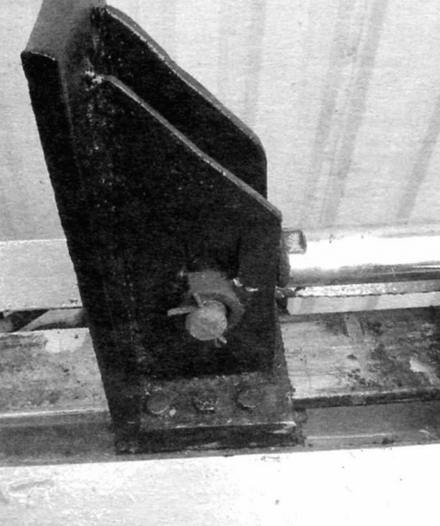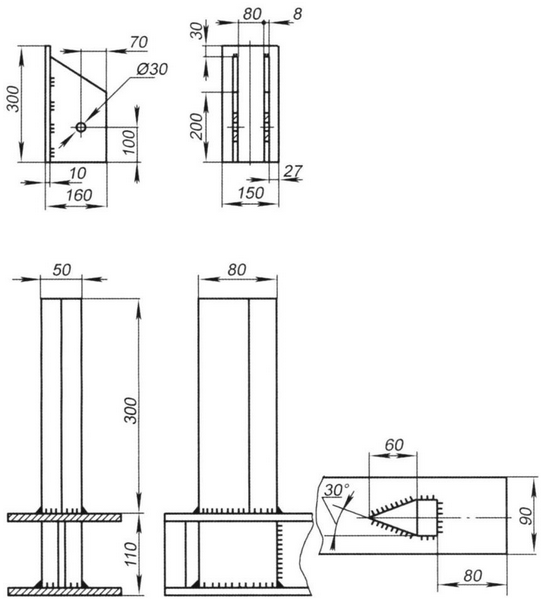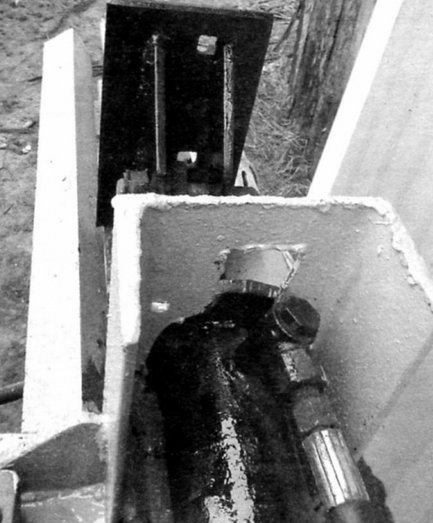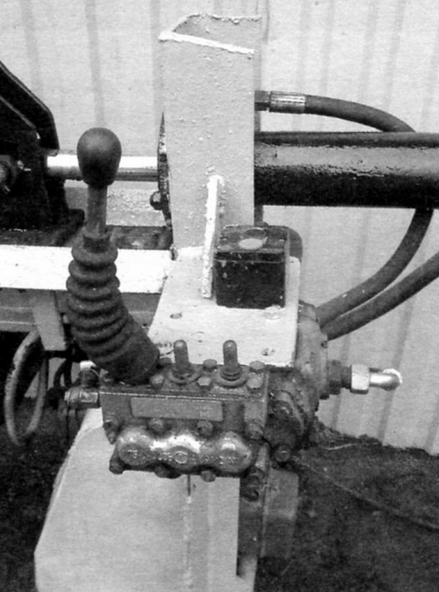 Free technical library
Free technical library
Wood splitter. Drawing, description

Directory / Tools and mechanisms for agriculture
 Comments on the article
Comments on the article
In the well-known encyclopedia of the century before last "Industry and Technology", in the volume concerning the "processing of fibrous substances", which is wood, it is said that "in works on the division of wood, ... splitting matters." And further: "a wedge-shaped tool unbends the separated parts of the tree; here the tree breaks at a distance greater than the tool can penetrate."
There is an unusual number of types of axes. But for splitting, the cleaver is most suitable. It's not just about its larger mass, longer swing handle. The main thing is in the sharper blade, in sharpening. Scientists have found that the optimal value of its sharpening is 40 ° -60 °. In this case, the side surfaces of the blade work, helping to separate the block, directing tensile forces in different directions, delaminating it into parts.
The principle of operation of a mechanical cleaver is no different from "manual splitting". But here, too, the blade must approach the block exactly parallel to its longitudinal fibers, otherwise the ax will simply get stuck in the tree. Therefore, it is necessary to ensure reliable stability, first of all, of the frame of the mechanism, along which the movement of its main parts takes place.
Therefore, a relatively powerful I-beam No. 18U with dimensions of 90x90x10 mm was chosen as the frame for the fixed guide of the wood splitter. On one side of it there is a splitting knife, on the other - a pusher acting from a power hydraulic cylinder with a pump and an electric motor. It would be desirable, besides, that the mechanism could be moved from place to place. To do this, it must have wheels on the front and rear pillars.
A block of wood moves along the bed with a hydraulic cylinder towards the splitting knife. This part was made from a steel blank (steel 45) with dimensions of 400x80x50 mm and sharpened on emery at 60 ° on the tip. At one end of the I-beam bed - on its upper shelf - I made a cutout, inserted a splitter vertically and welded it securely to both shelves.
At the other end of the bed, I welded a hydraulic cylinder stand. It was made from a channel with dimensions of 180x70x9 mm and a height of 400 mm. On its inner side, for mounting the hydraulic cylinder, I already welded a circular flange with four holes for bolts with a diameter of 14 mm. In its center is a hole for the passage of a cylinder rod with a diameter of 60 mm.

Wood splitter scheme: 1 - knife; 2 - pusher; 3 - hydraulic cylinder rod; 4 - hydraulic cylinder stand (channel 180x70x9); 5 - power hydraulic cylinder, stroke 600 mm (Ø90); 6 - mounting flange; 7 - control distributor; 8 - guide corners (50x50); 9 - electric motor 3,5 kW; 10 - oil pump drive NSh 32; 11 - front support; 12 - oil tank (20 l); 13 - brand base (90x90x 10); 14 - holder for guide corners (150x40x5); 15 - rear support

Pusher. Connection with hydraulic cylinder rod, rod diameter 50 mm

Knife and pusher on the frame. On the sides of the frame are placed guide corners with dimensions of 50x50 mm

Pusher, rod and flange for attaching the hydraulic cylinder to the rear rack
The pusher is made of steel sheet 10 mm thick. First, I cut out a board with dimensions of 150x300 mm and vertically welded two figured racks with dimensions of 270x150 mm with a side cut to it. I drilled a hole with a diameter of 30 mm for the finger of the hydraulic cylinder rod. Thus, the pusher itself could be connected to the power cylinder.
For the operation of the hydraulic cylinder, I picked up an electric motor of 3,5 kW with 1500 rpm. As it turned out, the power of the motor in the work was quite enough. From it I threw a belt pulley to the pump drive NSh 12 - an oil pump, geared with dimensions of 146x159x137 mm. Both placed on the edge of the wood splitter under the cylinder rack. An oil tank with a capacity of 20 liters was fixed under the bed in its center.
In order for the chump not to fall off the bed, along it on both sides at a distance of 90 mm, it was necessary to stretch guide corners with dimensions of 50x50 mm. They are mounted on three pairs of 40x5 mm holders bent at a right angle, which are welded to the bottom shelf of the brand.
The mechanism is controlled using the R-80 distributor from the MTZ tractor. True, somewhat modernized: removed from it the balls that lock the lever for security purposes.

Pusher

Cylinder rack (click to enlarge)

Rear pillar channel, 180x70x9 mm. Connecting the oil pump hose to the hydraulic cylinder

Assembling the right wood splitter assembly. In the foreground, the R-80 control distributor from the MTZ tractor

Electric motor and oil pump NSh 32 are connected by a belt pulley
Now, if the lever is released, it returns to its original position.
The stroke of the hydraulic cylinder rod is 600 mm, so blocks of 40 - 50 cm long can be placed on the frame. They split into two parts, but it is also possible to put a four-bladed knife.
The front and rear supports - on wheels - are made of pipes with a diameter of 50 mm. They are also welded to brand shelves.
A wood splitter of this design has been working on harvesting firewood for the house for four years without interruption. There were no breakdowns, and there was nothing special to break in it.
Author: R.Vlasov
 We recommend interesting articles Section Tools and mechanisms for agriculture:
We recommend interesting articles Section Tools and mechanisms for agriculture:
▪ Wood splitter
▪ Flat cutter Rudulis
▪ folding trolley
 See other articles Section Tools and mechanisms for agriculture.
See other articles Section Tools and mechanisms for agriculture.
 Read and write useful comments on this article.
Read and write useful comments on this article.
<< Back
 Latest news of science and technology, new electronics:
Latest news of science and technology, new electronics:
Machine for thinning flowers in gardens
02.05.2024
In modern agriculture, technological progress is developing aimed at increasing the efficiency of plant care processes. The innovative Florix flower thinning machine was presented in Italy, designed to optimize the harvesting stage. This tool is equipped with mobile arms, allowing it to be easily adapted to the needs of the garden. The operator can adjust the speed of the thin wires by controlling them from the tractor cab using a joystick. This approach significantly increases the efficiency of the flower thinning process, providing the possibility of individual adjustment to the specific conditions of the garden, as well as the variety and type of fruit grown in it. After testing the Florix machine for two years on various types of fruit, the results were very encouraging. Farmers such as Filiberto Montanari, who has used a Florix machine for several years, have reported a significant reduction in the time and labor required to thin flowers.
... >>
Advanced Infrared Microscope
02.05.2024
Microscopes play an important role in scientific research, allowing scientists to delve into structures and processes invisible to the eye. However, various microscopy methods have their limitations, and among them was the limitation of resolution when using the infrared range. But the latest achievements of Japanese researchers from the University of Tokyo open up new prospects for studying the microworld. Scientists from the University of Tokyo have unveiled a new microscope that will revolutionize the capabilities of infrared microscopy. This advanced instrument allows you to see the internal structures of living bacteria with amazing clarity on the nanometer scale. Typically, mid-infrared microscopes are limited by low resolution, but the latest development from Japanese researchers overcomes these limitations. According to scientists, the developed microscope allows creating images with a resolution of up to 120 nanometers, which is 30 times higher than the resolution of traditional microscopes. ... >>
Air trap for insects
01.05.2024
Agriculture is one of the key sectors of the economy, and pest control is an integral part of this process. A team of scientists from the Indian Council of Agricultural Research-Central Potato Research Institute (ICAR-CPRI), Shimla, has come up with an innovative solution to this problem - a wind-powered insect air trap. This device addresses the shortcomings of traditional pest control methods by providing real-time insect population data. The trap is powered entirely by wind energy, making it an environmentally friendly solution that requires no power. Its unique design allows monitoring of both harmful and beneficial insects, providing a complete overview of the population in any agricultural area. “By assessing target pests at the right time, we can take necessary measures to control both pests and diseases,” says Kapil ... >>
 Random news from the Archive Random news from the Archive Etiquette is in the genes
29.04.2012
Why do some people become donors or treat their neighbors with delicious pies, while others spread gossip and always swear? Scientists from the University of Buffalo and the University of California believe that the cause is a combination of genes and hormones.
It is believed that the hormones oxytocin and vasopressin affect how people relate to each other. Laboratory tests have shown that people communicate better and excel at economic games when they inhale an aerosol containing oxytocin. However, no large-scale studies on this topic have been conducted so far.
In the new study, instead of injecting oxytocin, scientists focused on the biology of hormones. Hormones work by binding to receptors in cells. These receptors have different forms, for example, the oxytocin receptor has two forms, and vasopressin has even more.
The study involved 711 experimental volunteers. They were asked various questions regarding civic duty: should they pay taxes, report a crime, are people around good or, on the contrary, bad, etc. At the same time, a saliva sample was taken from the respondents for DNA analysis and it was determined in what form the oxytocin and vasopressin receptors were.
It turned out that people who look at the world from a negative point of view and are less likely to help others do not have a form of receptor associated with kindness and a positive attitude towards people. The "positive" version of the gene allows you to overcome the feeling that the whole world is filled with danger, deceit and violence.
The results of the study do not indicate a direct relationship between genes and social behavior - most of the links between DNA and social behavior are very complex and much deeper than the form of receptors. However, generosity, caring, a sense of civic duty, etc. associated with certain genes, and this can be detected. It is possible that in the future, a person's potential integrity can be detected with a simple DNA test.
|
 Other interesting news:
Other interesting news:
▪ WiFi MP3 player
▪ Optoelectronic relay FTR-SL series
▪ Smart guide vest for the visually impaired
▪ Found a planet where it rains from precious stones
▪ MSP-EXP432P401R IoT Development Board
 News feed of science and technology, new electronics
News feed of science and technology, new electronics
 Interesting materials of the Free Technical Library:
Interesting materials of the Free Technical Library:
▪ section of the site Aphorisms of famous people. Article selection
▪ article Breathing incense. Popular expression
▪ article What language do gypsies speak? Detailed answer
▪ article Dactylorhiza spotted. Legends, cultivation, methods of application
▪ article Stand for measuring the throughput of carburetor jets. Encyclopedia of radio electronics and electrical engineering
▪ article Stubborn asterisk. physical experiment
 Leave your comment on this article:
Leave your comment on this article:
 All languages of this page
All languages of this page
Home page | Library | Articles | Website map | Site Reviews

www.diagram.com.ua
2000-2024







 Arabic
Arabic Bengali
Bengali Chinese
Chinese English
English French
French German
German Hebrew
Hebrew Hindi
Hindi Italian
Italian Japanese
Japanese Korean
Korean Malay
Malay Polish
Polish Portuguese
Portuguese Spanish
Spanish Turkish
Turkish Ukrainian
Ukrainian Vietnamese
Vietnamese










 See other articles Section
See other articles Section 